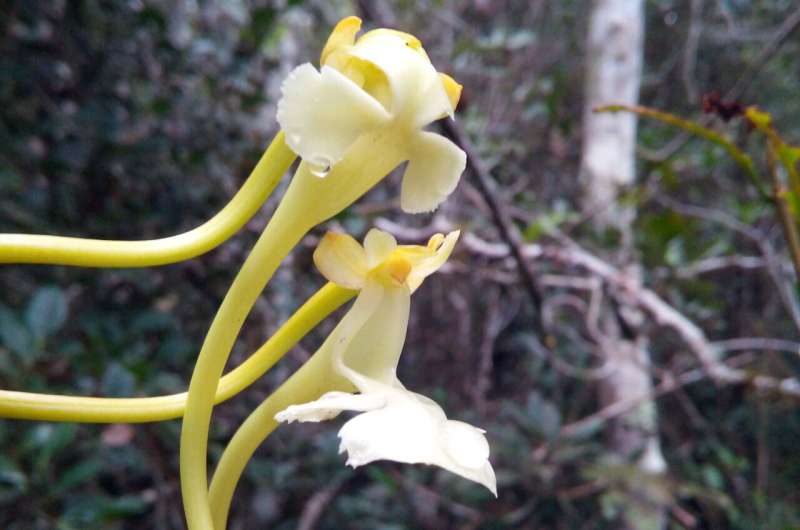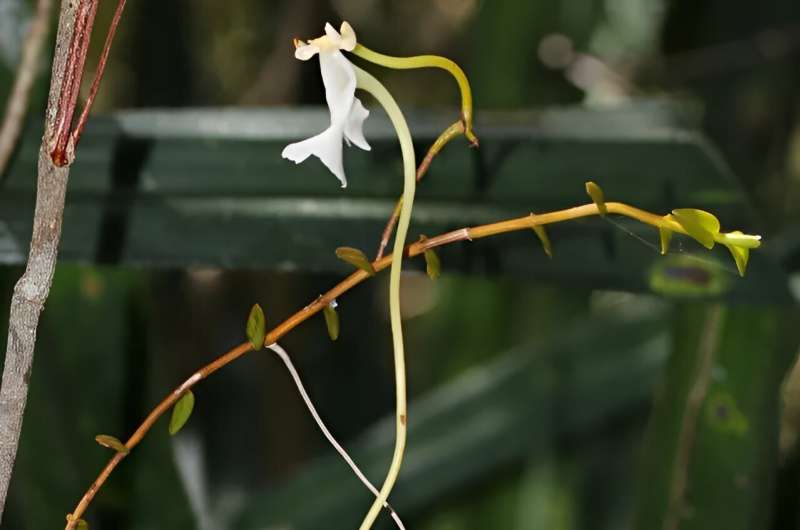This article has been reviewed according to Science X's editorial process and policies. Editors have highlighted the following attributes while ensuring the content's credibility:
fact-checked
proofread
Scientists describe new orchid species related to famous Darwin's orchid

Missouri Botanical Garden scientists and collaborators discovered and described a new orchid species in Central Madagascar with a record-setting nectar spur and close ties to the famous "Darwin's orchid." This novelty species needs urgent conservation action, scientists say.
"Discovering a new orchid species is always an exciting event, but finding such amazing and charismatic species happens only once in a scientist's career. I really hope that this highly threatened species draws attention to the urgent crisis that is affecting Madagascar's biodiversity and helps support Garden's program there," said Tariq Stévart, Director of the Garden's Africa and Madagascar program.
The flora of Madagascar is known for flowers with elongated floral tubes pollinated by long-tongued hawkmoths. The most famous of these species, Angraecum sesquipedale, is known as Darwin's orchid, to pay tribute to Charles Darwin's theory that the flower was pollinated on a not-yet-discovered moth with a long proboscis. Scientists described the large hawkmoth, Xanthopan praedicta, 41 years after his prediction.
A newly published paper, "A new orchid species expands Darwin's predicted pollination guild in Madagascar," reveals an unexpected new case of parallel evolution with Darwin's orchid in the newly described giant spurred Solenangis impraedicta whose nectar spur reaches a whopping 33 cm in length.
The study is published in the journal Current Biology.
"The contrast between the little 2-cm flowers and the hyper-long nectar tube is mind-blowing," said co-author João Farminhão of the Coimbra University Botanic Garden.
Solenangis impraedicta has the third longest spur ever recorded among flowering plants, and the longest nectar spur of any known plant relative to flower size. It is the only new orchid species with such an extreme adaptation to hawkmoth pollination described since 1965.
Patrice Antilahimena, a Garden field botanist, first collected the species during the baseline environmental impact study of a mine site in Central-Eastern Madagascar. Ten years later, Garden Botanist Brigitte Ramandimbisoa and Simon Verlynde, Ph.D. student at the New York Botanical Garden, discovered a new location. The novelty belongs to the angraecoid orchids group that Stévart and an international team of experts have extensively studied. Stévart, an expert in African orchid taxonomy and conservation, first identified this species as an undescribed species of Solenangis.

This sensational new member of "Darwin's pollination guild" is threatened by mining activities and potentially by poaching for the orchid trade.
"A precautionary approach is required when publishing such a spectacular new species. Wild populations must be protected and monitored and detailed information on their precise coordinates must be kept out of the public domain. So, don't ask us to reveal where we found it, somewhere in Madagascar," added Stévart.
The 15-year gap between this species' discovery and formal description allowed the team to implement conservation measures before the giant-spurred Solenangis achieves stardom. These include ex situ cultivation and seed banking as part of a collaboration between the Garden and the Ambatovy Conservation Department.
The pollination biology of Solenangis impraedicta was preliminarily studied using camera traps by Marie Savignac in 2019.
The observational period did not result in any conclusive pollination events, but the most likely pollinators are the large hawkmoths Coelonia solani and Xanthopan praedicta. The species name "impraedicta" (meaning unpredicted in Latin) is a nod to Darwin's prediction of the star orchid pollinator, which took 130 years to confirm in full. Hopefully, this time it won't take as long to identify the pollinator in the act.
More information: João Farminhão et al, A new orchid species expands Darwin's predicted pollination guild in Madagascar, Current Biology (2024). DOI: 10.1016/j.cub.2024.01.012
Provided by Missouri Botanical Garden


















